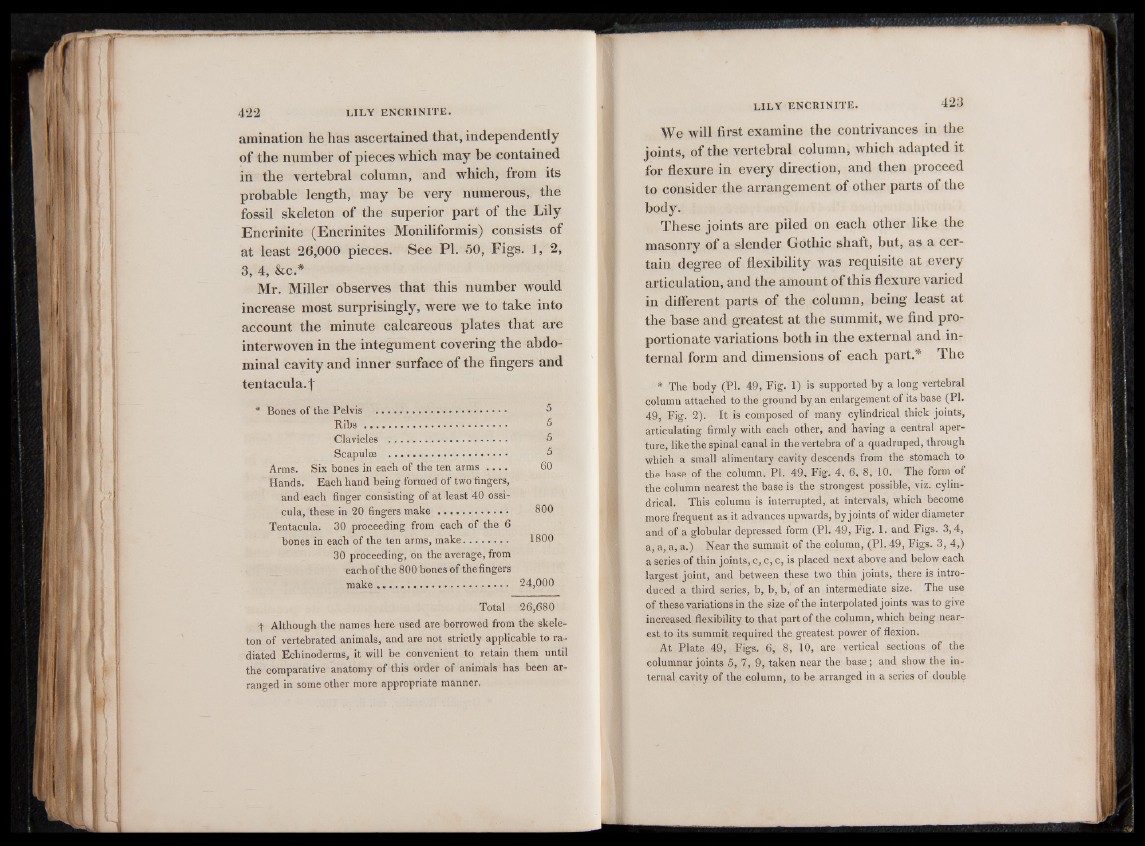
animation he has ascertained that, independently
of the number of pieces which may be contained
in the vertebral column, and which, from its
probable length, may be very numerous, the
fossil skeleton of the superior part of the Lily
Encrinite (Encrinites Moniliformis) consists of
at least 26,000 pieces. See PI. 50, Figs. 1, 2,
3, 4, &c.*
Mr. Miller observes that this number would
increase most surprisingly, were we to take into
account the minute calcareous plates that are
interwoven in the integument covering the abdominal
cavity and inner surface of the fingers and
tentacula.j'
* Bones of the Pelvis ................................................. 5
Ribs ................ 5
Clavicles ............................................. 5
Scapulae ............................................ 5
Arms. Six bones in each of the ten arms . . . . 60
Hands. Each hand being formed of two fingers,
and each finger consisting of at least 40 ossicula,
these in 20 fingers m a k e ......................... 800
Tentacula. 30 proceeding from each of the 6
bones in each of the ten arms, make................. 1800
30 proceeding, on the average, from
eachofthe 800 bones of thefingers
make..................................... 24,000
Total 26,680
+ Although the names here used are borrowed from the skeleton
of vertebrated animals, and are not strictly applicable to radiated
Echinoderms, it will be convenient to retain them until
the comparative anatomy of this order of animals has been arranged
in some other more appropriate manner.
LILY ENCRINITE. 423
We will first examine the contrivances in the
joints, of the vertebral column, which adapted it
for flexure in every direction, and then proceed
to consider the arrangement of other parts of the
body.
These joints are piled on each other like the
masonry of a slender Gothic shaft, but, as a certain
degree of flexibility was requisite at every
articulation, and the amount of this flexure varied
in different parts of the column, being least at
the base and greatest at the summit, we find proportionate
variations both in the external and internal
form and dimensions of each part.* The
* The body (PI. 49, Fig. 1) is supported by a long vertebral
column attached to the ground by an enlargement of its base (PI.
49, Fig. 2). It is composed of many cylindrical thick joints,
articulating firmly with each other, and having a central aperture,
like the spinal canal in the vertebra of a quadruped, through
which a small alimentary cavity descends from the stomach to
the base of the column, PI. 49, Fig. 4, 6, 8, 10. The form of
the column nearest the base is the strongest possible, viz. cylindrical.
This column is interrupted, at intervals, which become
more frequent as it advances upwards, by joints of wider diameter
and of a globular depressed form (PI. 49, Fig. 1. and Figs. 3,4,
a, a, a, a.) Near the summit of the column, (PI. 49, Figs. 3, 4,)
a series of thin joints, c, c, c, is placed next above and below each
largest joint, and between these two thin joints, there is introduced
a third series, b, b, b,' of an intermediate size. The use
of these variations in the size of the interpolated joints was to give
increased flexibility to that part of the column, which being nearest
to its summit required the greatest power of flexion.
At Plate 49, Figs. 6, 8, 10, are vertical sections of the
columnar joints 5, 7, 9, taken near the base; and show the internal
cavity of the column, to be arranged in a series of double